Restore Your Favorite Clothes: Understanding Garment Stretchers
A garment stretcher is a specialized tool designed to restore shrunken clothing to its original size by applying controlled tension to the fabric.
| What is a Garment Stretcher? | Quick Facts |
|---|---|
| Purpose: | Restores shrunken clothing to original dimensions |
| Types: | Shirt stretchers, hat stretchers, shoe stretchers, glove stretchers |
| Materials: | Typically wood (maple), metal, or polyurethane |
| Price Range: | $5-$60 depending on type and quality |
| Effectiveness: | Can recover up to 3-4% shrinkage in natural fibers |
Have you ever pulled a favorite shirt from the dryer only to find it's now too small? Whether it's a cotton tee that's shrunk or a linen garment that's lost its shape, a garment stretcher offers a simple solution to this common frustration.
Unlike steamers or irons that primarily target wrinkles, garment stretchers work by applying uniform tension to help fibers relax and return to their original dimensions. This makes them particularly effective for natural fabrics like cotton, wool, and linen that are prone to shrinkage when exposed to heat and moisture.
The beauty of a garment stretcher lies in its simplicity and effectiveness. Most models work using basic physics—applying weight or mechanical tension in strategic places to gently pull fabric back to size without damaging the material. This not only saves money by extending the life of your clothes but also reduces waste by keeping perfectly good items from being discarded.
I'm Mortuary Cooler, a national-level supplier specializing in durable equipment including garment stretchers that help professionals maintain quality presentation. My experience with high-quality stretching tools has shown they're an essential investment for anyone seeking to extend the life of valuable garments.
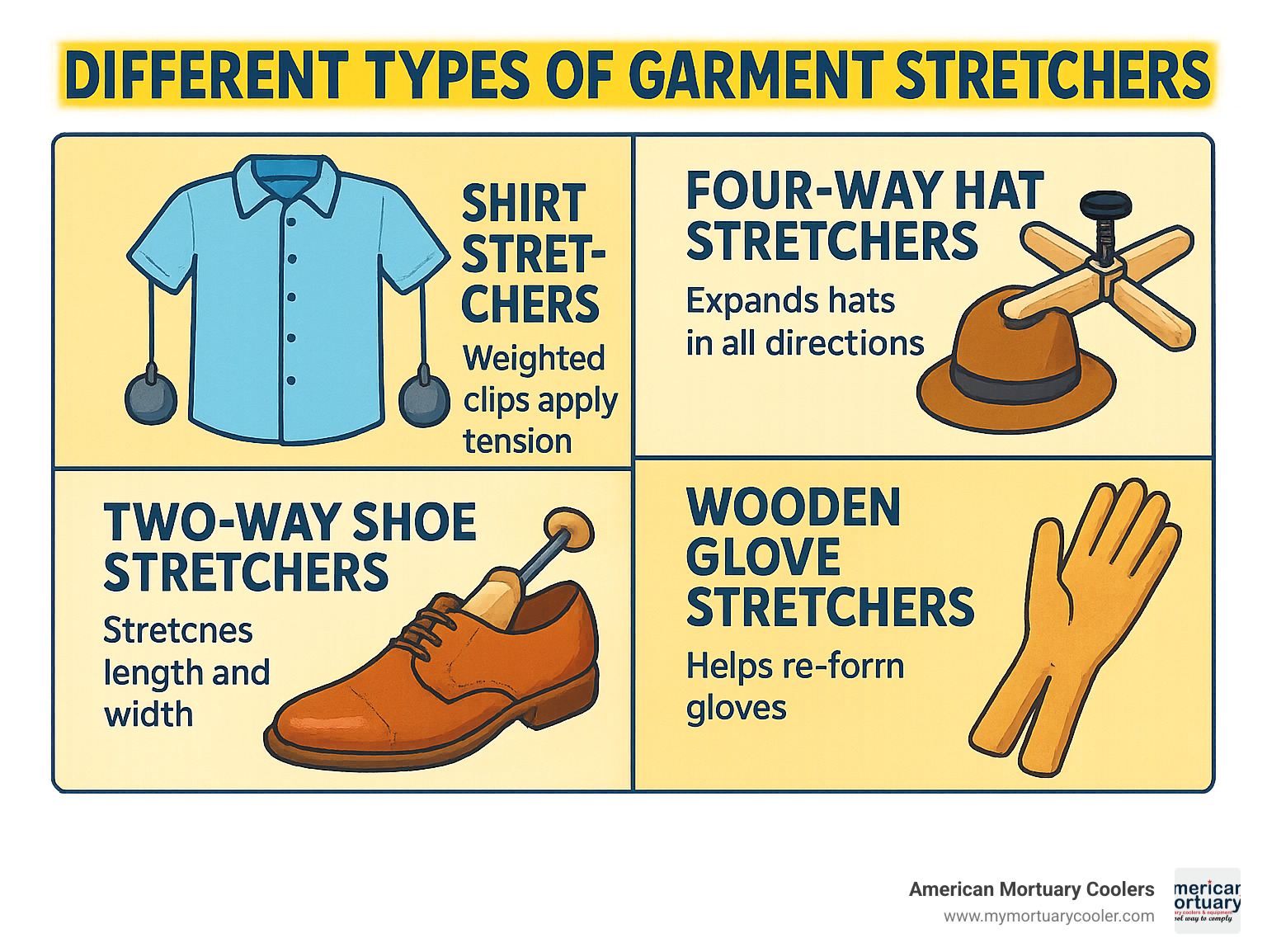
Garment stretcher vocab to learn:
Garment Stretcher 101: Definition, Mechanics & Science
Ever wonder how a simple tool can rescue your favorite shrunken sweater? The science behind garment stretchers is actually pretty fascinating, and it's all about giving those cramped fibers some breathing room again.
When your clothes shrink, what's really happening is the fabric fibers are huddling closer together—like commuters squeezing into a packed subway car. This is called relaxation shrinkage, and it happens most often with natural fibers like cotton, wool, and linen. A garment stretcher works by gently coaxing those fibers back to their original positions.
"There's nothing more annoying than a shirt that rides up," as one stretcher manufacturer puts it—and I think we can all relate to that uncomfortable feeling!
How Does a Garment Stretcher Work?
Most garment stretchers use one of two clever approaches:
The first type uses weighted clips—typically with a 3-clip design that hangs from your clothing's hem. Gravity does all the heavy lifting here as the weight gently pulls downward, helping fibers relax back to their natural state.
The second type uses mechanical expansion—think of these as the ones that physically push outward from inside hats, shoes, or gloves to restore their shape.
For best results, most stretching works better with a little moisture. When fibers are slightly damp, they become more pliable—like how your hair is easier to style when it's not completely dry. This is why instructions often suggest using a garment stretcher on damp (but not soaking wet) clothing.
Materials & Durability Factors
The materials in your garment stretcher matter quite a bit—both for how well it works and how long it lasts.
Maple wood is a popular choice, especially for hat and glove stretchers. It's sturdy but gentle on your precious fabrics. As one reviewer mentioned, "Wooden glove stretchers, especially maple, offer the best durability and versatility."
Polyurethane stretchers are common for shoes because they can flex and conform to irregular shapes while maintaining strength. Metal alloys provide the necessary weight for shirt stretchers, while some clever designs use hollow weights you can fill with sand to customize the tension based on your particular fabric.
"Plastic or branded stretchers can outlast wooden versions without cracking," according to industry experts—though like anything, quality varies widely by brand and construction.
Garment Stretcher vs. Other Devices
While steamers and irons might be your go-to for wrinkles, they can't perform the same magic as a garment stretcher when it comes to actual size restoration:
| Feature | Garment Stretcher | Steamer | Iron |
|---|---|---|---|
| Primary Purpose | Restores size/dimensions | Removes wrinkles | Removes wrinkles and creases |
| Mechanism | Tension and weight | Steam relaxation | Heat and pressure |
| Effect on Shrinkage | Can reverse shrinkage | Minimal effect on shrinkage | No effect on shrinkage |
| Fabric Impact | Gentle on fibers | Very gentle on fibers | Can damage delicate fabrics |
| Time Required | Hours to days | Minutes | Minutes |
| Best For | Restoring shrunken clothes | Quick wrinkle removal | Precise creasing and pressing |
Unlike wrinkle-release sprays that just temporarily smooth things out, a good garment stretcher can actually restore your clothing's physical dimensions. Steam cabinets might relax fibers somewhat, but they can't apply that steady, directional tension needed to truly bring back your garment's original size.
As one fabric care expert noted, "Garment stretchers and stretching techniques are valuable for restoring fit"—something that makes them uniquely helpful in your clothing care arsenal.
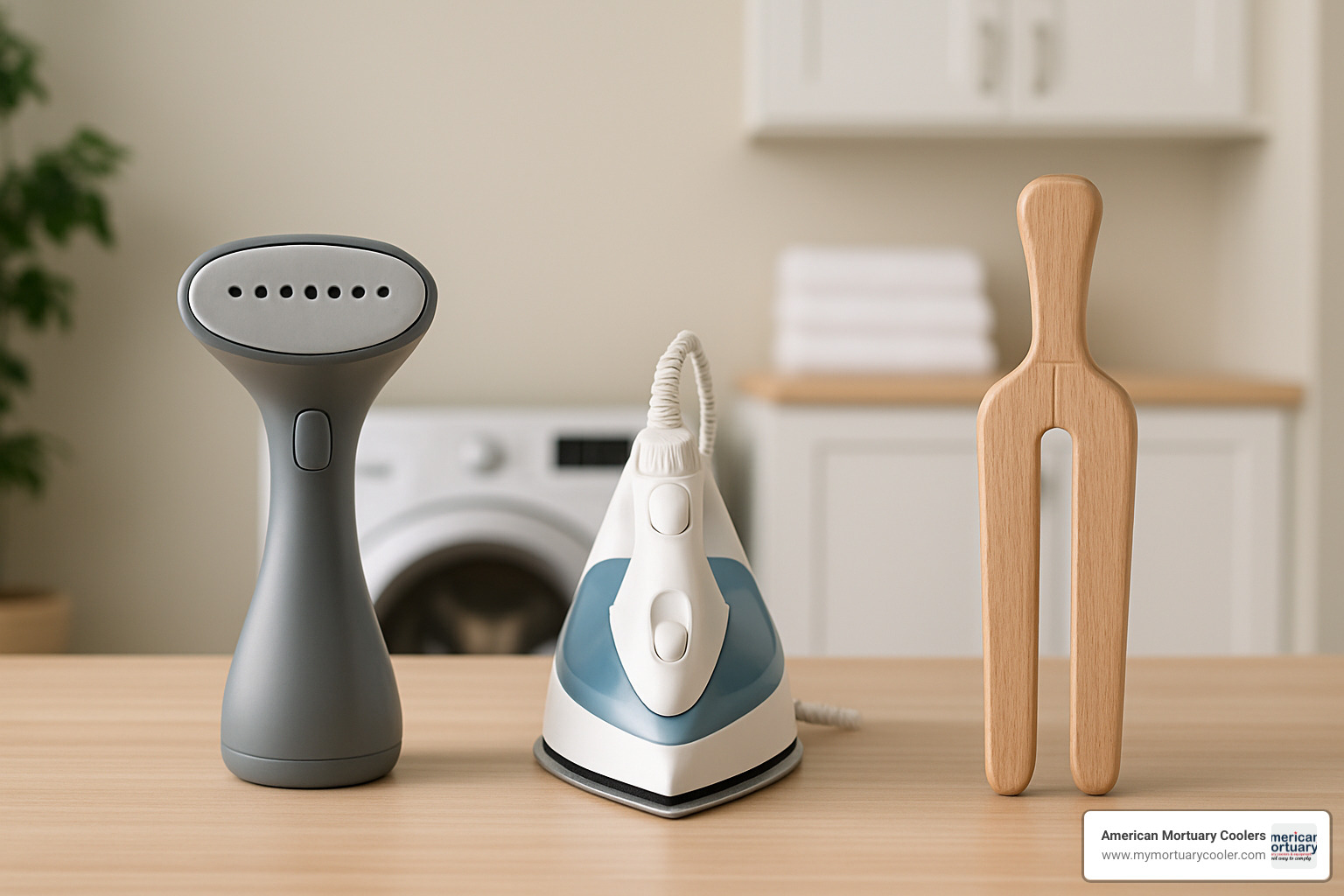
From Shirts to Shoes: The Main Types of Garment Stretchers
The world of garment stretchers is delightfully diverse – like having the right tool for every job in your wardrobe rescue kit. Let's explore these specialized tools that can save your favorite clothes from the donation pile.
Shirt Stretchers
Sinking feeling when your favorite tee comes out of the dryer looking like it belongs to a child? Shirt stretchers come to the rescue with their clever design of clip-on weight bars that attach to your shirt's bottom hem.
The most effective models use a three-point attachment system – think of it as a trio of gentle helpers pulling your shirt back to its proper length. One clip at each end and one in the middle ensures the weight distributes evenly, preventing that awkward lopsided stretch.
"Our handmade shirt stretchers gently restore length, saving money and extending wardrobe life," explains one passionate manufacturer. These simple yet effective tools work wonders on everything from casual t-shirts to your crisp button-ups.
Short on cash? Many resourceful folks create DIY alternatives using hangers and household weights. While these homemade solutions can work in a pinch, purpose-built stretchers typically deliver more consistent results without risking damage to your precious fabrics.
Hat Stretchers (Four-Way)
Hat stretchers might be the most ingenious of all garment stretchers, designed specifically for the unique curves and materials of your favorite headwear.
Take the Four Way Hat Stretcher from American Hat Makers – with an impressive 4.8-star rating from 46 reviews, it's clearly doing something right. According to their website, "This Hat Stretcher is the ideal way to maintain the size of any hat while storing." With 98% of customers recommending it, the proof is in the pudding.
These clever devices expand in four directions simultaneously (front-to-back and side-to-side), ensuring uniform pressure throughout the crown. This is particularly important for materials like felt and straw, which can become misshapen if stretched unevenly.
One delighted customer shared how they "stretched a 7⅜ vintage hat from display to wearable" – bringing new life to what might have been a museum piece rather than a wearable treasure.
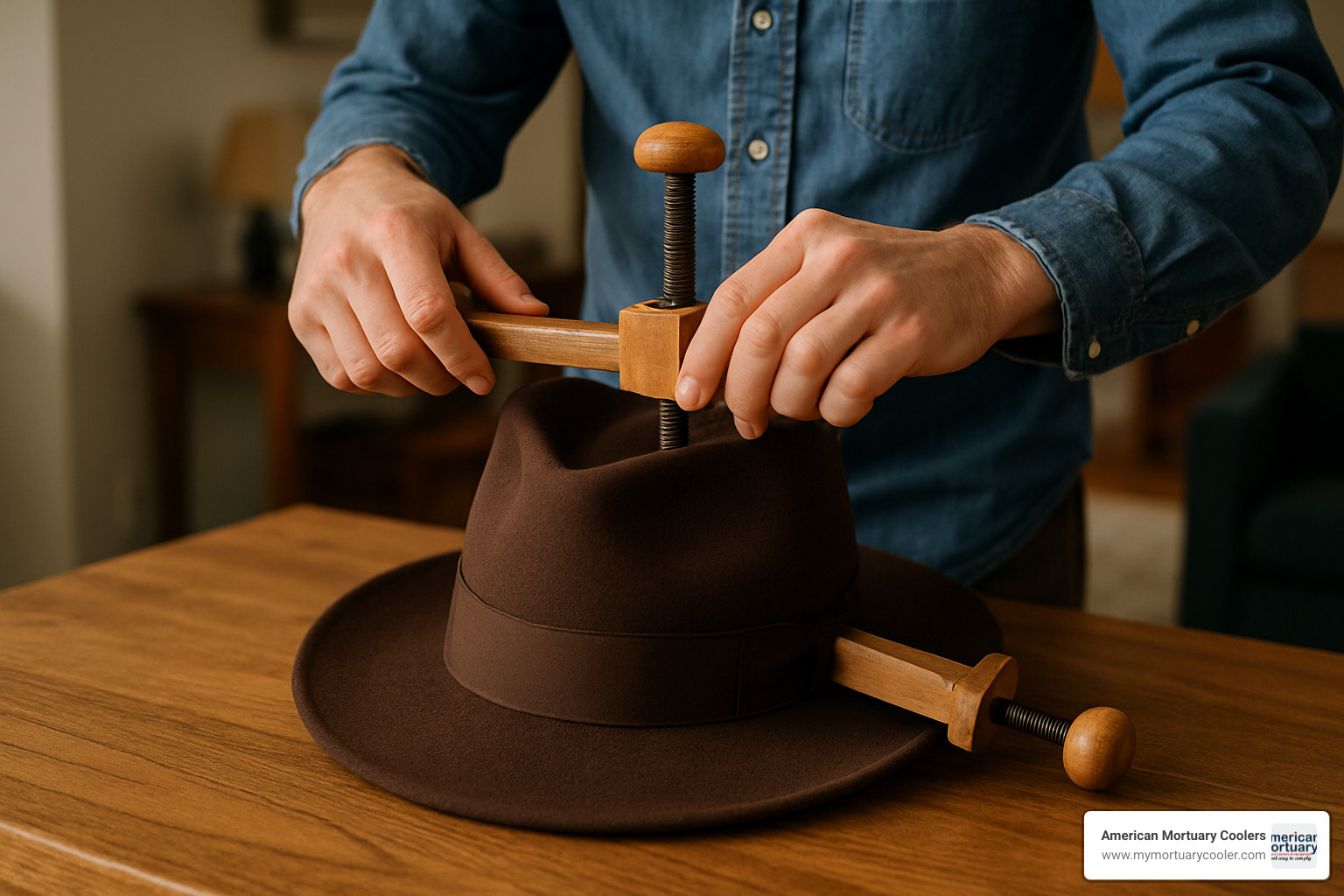
Shoe Stretchers
Anyone who's endured the agony of breaking in new shoes will appreciate the brilliance of shoe stretchers. These two-way adjustable devices can increase both the length and width of your footwear, sparing you those painful blisters.
What makes quality shoe stretchers truly special are their thoughtful features like bunion plugs – small protrusions you can insert at specific points to create extra room exactly where you need it. Got a pinching toe box or a rubbing heel? A good shoe stretcher can target these trouble spots with precision.
Most shoe stretchers come in various sizes (Small, Medium, Large, Xtra Large) to accommodate everything from delicate flats to sturdy boots. Their polyurethane construction offers durability while remaining gentle enough for fine leather – the perfect balance of strength and care.
Glove Stretchers
Perhaps the most specialized member of the garment stretcher family, glove stretchers feature wooden "fingers" that expand to restore shape to your favorite hand coverings. While traditionally used for leather and kid gloves, creative sewers and tailors have found numerous additional uses for these unique tools.
"Glove stretchers can serve as open clamps for tight corners in any sewing project, not just gloves," reveals one sewing expert. Their distinctive design makes them surprisingly versatile beyond their original purpose.
Most wooden glove stretchers cost between $5 and $25, with maple being the gold standard material due to its durability and gentle interaction with fabrics. While you might spot antique silver or ivory versions, these are best left as display pieces, as they can potentially damage your precious gloves.
Specialty & Patent-Inspired Bars
Innovation continues to thrive in the garment stretcher market, with several patent-inspired designs offering clever features. One standout example includes stretchers with removable sand weights that let you customize the tension based on your fabric type and desired results.
These specialty stretchers often feature custom clip spacing to accommodate different garment styles and sizes. As one patent eloquently describes, they use "an elongated weight with equidistant clips and rotatable eyelets to apply even force across the garment width," providing more controlled and effective stretching.
While these innovative models might cost a bit more than standard versions, they can deliver superior results, especially for challenging fabrics or uniquely constructed garments. Think of them as the power tools in your garment care workshop – worth the investment when you need that extra level of precision.
Key Benefits, Drawbacks & Real-World Outcomes
When you invest in a garment stretcher, you're getting more than just a tool—you're getting a way to extend the life of your favorite clothes. I've seen how these simple devices can transform a disappointing laundry mishap into a wardrobe save.
Top Benefits of Using a Garment Stretcher
That sinking feeling when you pull your favorite shirt from the dryer only to find it's shrunk? A garment stretcher can turn that moment around.
The cost savings alone make these tools worthwhile. Think about it—rather than replacing that $50 linen shirt or $150 wool sweater, a one-time investment in a quality stretcher could save you hundreds of dollars annually. As one customer told me, "I've saved my favorite cashmere sweater three times now with my stretcher—it's paid for itself many times over."
The revival aspect is particularly impressive with natural fibers. Pure linen, for instance, can shrink up to 3-4% even with careful washing. A good garment stretcher can recover much of this loss, breathing new life into pieces you might otherwise reluctantly donate or discard.
Beyond fixing shrinkage, these tools offer something special—the ability to personalize your fit. I especially love how shoe stretchers with bunion plugs create targeted relief in exactly the spots where you need it, without compromising the overall structure of the shoe.
For the environmentally conscious among us (and shouldn't that be all of us?), extending garment life represents a small but meaningful step toward sustainability. Keeping clothes in circulation longer means fewer resources used and less waste in landfills. As I like to say, caring for your wardrobe is caring for our planet.
The comfort improvements can be dramatic, particularly with footwear. One customer shared how stretching her tight leather shoes "made the difference between limping by noon and comfortably wearing them all day." Those with bunions or corns often find particular relief.
And let's not forget the confidence boost that comes with properly fitting clothes. When your shirt stays tucked, your hat sits right, and your shoes don't pinch—you simply feel better about yourself and your appearance.
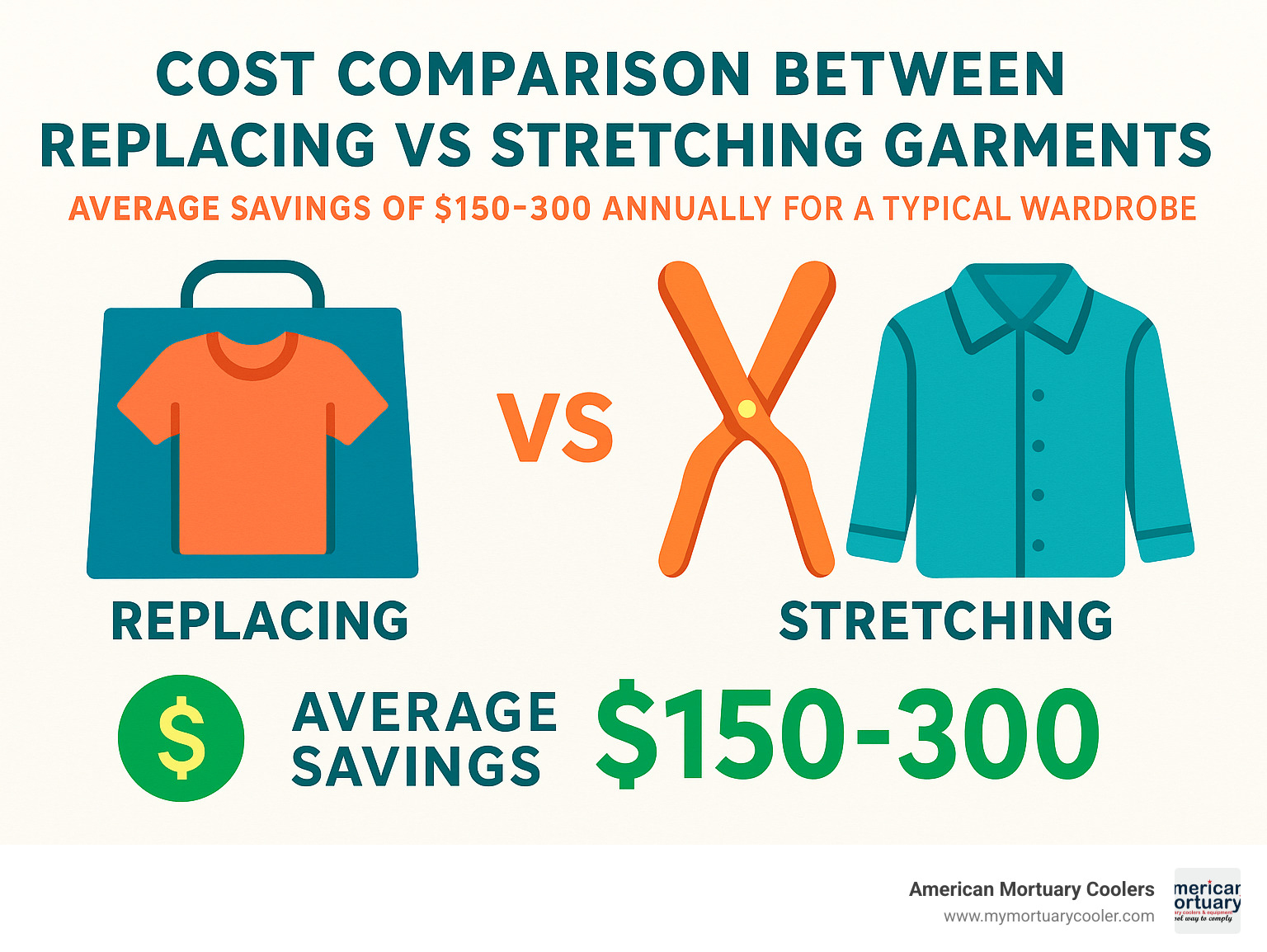
Potential Limitations & How to Avoid Them
While I'm clearly a fan of garment stretchers, I believe in honest conversations about their limitations too.
The risk of over-stretching is real. Just like you can't un-cook an overcooked steak, you can't easily reverse an over-stretched garment. The key is checking progress regularly—I recommend every 30 minutes at first—and removing the stretcher once you've achieved your desired size. Start conservatively; you can always stretch more if needed.
Fabric stress at clip points is another concern, especially with delicate materials. I've found that placing a small piece of cloth between the clip and garment works wonders. Some higher-end stretchers come with padded clips specifically to address this issue.
Perhaps the biggest adjustment for new users is the time requirement. Unlike ironing, which gives immediate results, stretching requires patience. Good results might take hours or even days. As one experienced user wisely shared, "Stretch gradually and leave the device in place for at least overnight—rushing the process never works well."
Not all fabrics respond equally to stretching. Natural fibers like cotton, wool, and linen are the stars of the show, readily responding to gentle tension. Synthetic materials like polyester or nylon? They're more stubborn, often showing limited improvement. Blended fabrics fall somewhere in between, with results depending on the specific blend.
At American Mortuary Coolers, we understand the importance of quality tools that deliver reliable results. While our specialty lies elsewhere, we appreciate the value of well-crafted equipment designed to last—whether it's cooling systems or the humble but effective garment stretcher.
Step-by-Step Guide: Using a Garment Stretcher for Each Fabric
Different fabrics have their own unique personalities when it comes to stretching. Just like people, some are naturally more flexible while others need a bit more coaxing. Let's walk through how to get the best results with various materials using your garment stretcher.
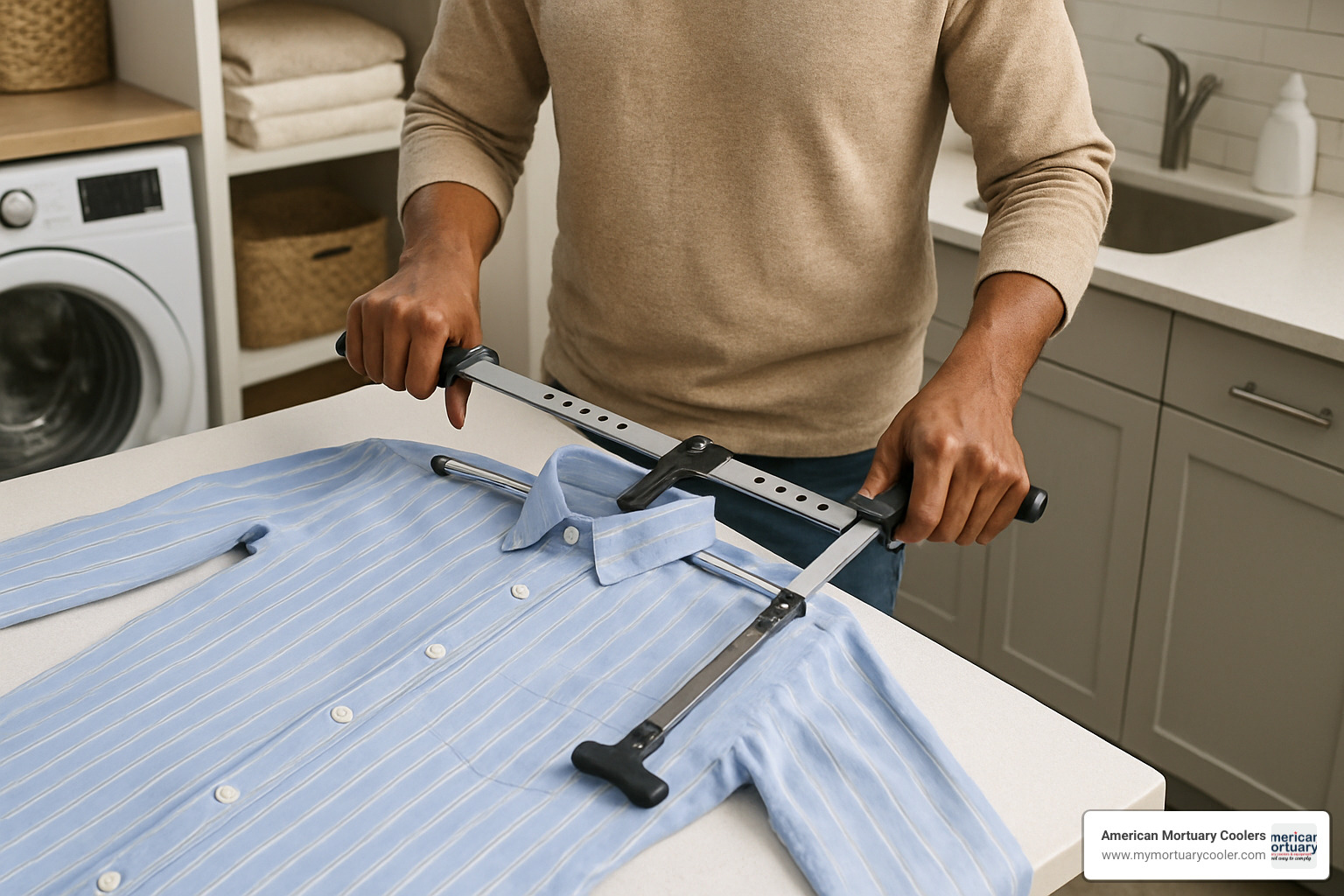
Using a Garment Stretcher on Linen Without Damage
Linen is wonderfully responsive to stretching, but it's also like that friend who remembers every little thing you've ever done wrong. Handle it carelessly, and it won't let you forget it.
"Pure linen shrinks when exposed to water and heat, losing up to 3–4% of its original size due to relaxation shrinkage," fabric experts tell us. But don't worry – with some gentle care, we can coax it back.
Start by preparing a lukewarm bath for your linen garment. Add a cup of hair conditioner or fabric softener to the water – this helps the fibers relax, like a spa day for your shirt. Let it soak for about 20-30 minutes, giving those fibers time to loosen up.
When removing your linen from its bath, resist the urge to wring it out! Instead, gently squeeze excess water and roll it in a dry towel. While the garment is still damp (this is crucial), attach your garment stretcher. For shirts, clip those weights evenly across the bottom hem – left, center, and right for balanced tension.
Take a moment to gently pull the damp fabric in all directions with your hands. This "re-blocking" helps realign the fibers before letting the stretcher take over. Then allow everything to air dry completely with the stretcher in place. As one linen expert wisely notes, "Re-blocking is the only way to restore pure linen garments."
For more detailed guidance, check out How to Easily Stretch Linen.
Cotton, Denim & Blends
Cotton and its cousins (including sturdy denim) are generally friendly to stretching, but they appreciate a little steam assistance first.
Either lightly mist your cotton garment with water or hang it in a steamy bathroom for 10-15 minutes. You want the fibers damp but not soaking wet. This moisture makes cotton much more cooperative.
When applying your garment stretcher, start with moderate tension. Cotton can be a bit of an overachiever and may continue stretching over time, so it's better to begin conservatively. You can always add more tension later if needed.
The key with cotton is regular check-ins. Take a peek every 30 minutes at first, then every few hours. This prevents your favorite t-shirt from becoming a dress! If it needs more stretching after drying, simply repeat the process with slightly more tension.
Denim, with its tighter weave, might need a few repeat sessions before you see significant results. Think of it as the stubborn teenager of fabrics – it'll come around eventually if you're patient.
Leather Shoes & Gloves
Leather requires special treatment – it's essentially transformed skin, after all. Create a simple stretching solution by mixing equal parts rubbing alcohol and water in a spray bottle. The alcohol helps the leather become more pliable.
Spray this solution lightly on the areas that need stretching. For shoes, focus on those spots that pinch your feet; for gloves, apply more evenly across the material.
While the leather is still damp from your solution, insert your shoe or glove stretcher. Turn the expansion mechanism until you feel resistance – but don't force it! Leather responds better to gentle persuasion than brute force.
Leave your stretcher in place overnight, giving the leather at least 8-12 hours to adapt to its new shape. Afterward, don't skip the conditioning step – stretched leather can get dry and cranky without some moisturizing treatment.
As one shoe professional shared with me, "The magic formula is combining heat, moisture, and stretcher use." It's like a perfect recipe – all ingredients need to be present for the best results.
Wool & Hats
Wool, especially in hats, needs to be handled with particular care. Too much moisture or heat can cause felting – where those fibers lock together permanently in ways you definitely don't want.
Use very low steam or the lightest water spray possible to dampen wool items. If you're using a mechanical hat stretcher, increase tension very gradually. Think tiny adjustments – just a quarter turn of the expansion mechanism at a time.
Allow your hat or wool garment to completely dry and cool with the stretcher in place. This cooling-down period is when the new dimensions really set into the fabric's memory.
According to American Hat Makers, "Store hats on the stretcher to maintain shape." This is particularly wise for wool hats, which benefit from occasional gentle re-stretching to keep their proper form.
Troubleshooting Common Garment Stretcher Mistakes
Even careful stretching can sometimes go awry. If you notice uneven stretching, first check that your stretcher is positioned correctly. For shirt stretchers, verify all clips are secured at the same height – even small differences can create noticeable unevenness.
Fabric puckering usually means you've applied too much tension too quickly. Think of it as asking your fabric to run before it can walk. Remove the stretcher, let the fabric rest, then reapply with gentler tension.
Those annoying clip impressions can be avoided by placing a thin cloth between the clip and garment. Some stretchers come with rubber padding on the clips specifically to prevent this issue.
If you're seeing no results at all, check what your garment is made from. Synthetic fabrics can be surprisingly resistant to stretching efforts. Natural fibers are much more willing participants in the stretching process.
Remember what one fabric expert wisely noted: "Do not wring linen fibers too hard to avoid damage." This gentle approach works best for all fabrics – patience and moderation will always give you better results than forcing things.
At American Mortuary Coolers, we understand the importance of proper care and maintenance for all types of materials. Whether it's specialized equipment or your favorite garments, taking the time to use the right techniques makes all the difference in extending usable life.
Smart Buying, Care & Final Thoughts
Investing in the right garment stretcher can make the difference between effective restoration and potential damage to your clothing. After helping countless professionals maintain their equipment, I've learned that quality matters tremendously for these simple yet effective tools.
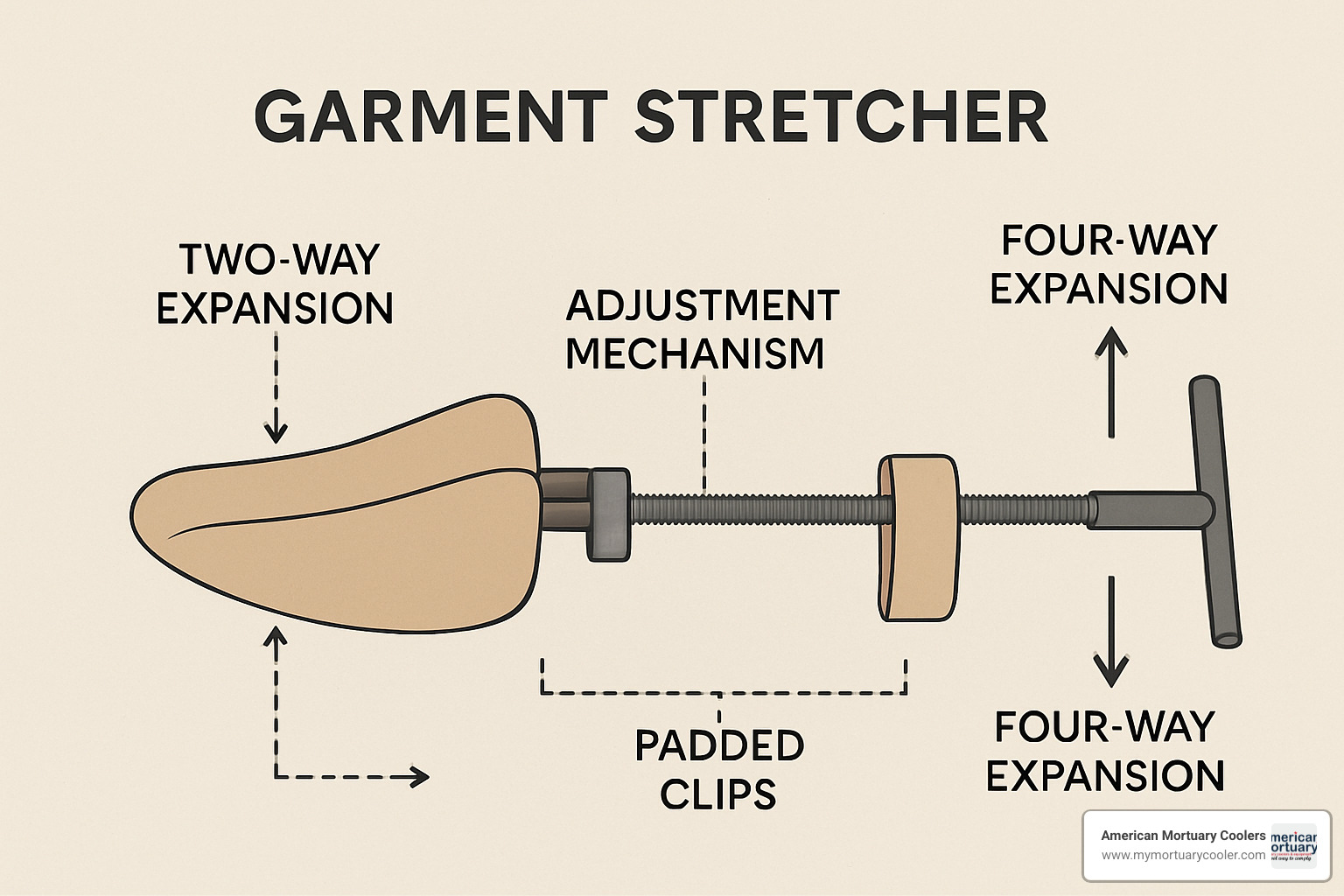
Must-Have Features & Materials
When shopping for a garment stretcher, you'll want to focus on what will give you the best results for years to come.
First, consider the directional capability you need. Two-way stretchers extend in length and width, perfect for basic needs. Four-way stretchers expand in all directions, offering more comprehensive restoration but typically at a higher price point. For most home users, a two-way model handles the majority of stretching tasks beautifully.
Look for adjustable clips or mechanisms that can accommodate different garment sizes. I've seen too many people struggle with fixed-size stretchers that limit their versatility. For shirt stretchers specifically, rubber-padded clips are worth their weight in gold – they prevent those telltale marks that can ruin the restoration effect.
Material quality makes a tremendous difference in longevity. As one happy customer shared, "The brand is well made and will serve many years." Moisture-resistant woods like maple work wonderfully for hat and glove stretchers, while durable metals or high-grade plastics stand up to the tension required for shirt stretching.
Weight capacity matters too, especially for weighted stretchers. Some of my favorite models offer customizable weight options, giving you control over how much tension you apply to different fabric types.
At American Mortuary Coolers, we've built our reputation on crafting durable equipment that stands the test of time. This same principle applies to choosing a garment stretcher – invest in quality now to avoid replacements later.
Where to Buy & Typical Pricing
You can find garment stretchers in several places, each with their own advantages. Online marketplaces like Amazon, eBay, and Etsy offer incredible variety. I've spotted wooden glove stretchers on eBay ranging from just $5 for basic models to $25 for finely crafted pieces.
Traditional haberdashers often carry premium hat and shoe stretchers. While you might pay more, you're generally getting expert advice and higher quality craftsmanship that online listings might not communicate well.
Many manufacturers like American Hat Makers sell directly to consumers. I've found these direct relationships often provide better customer support and more specialized options custom to specific needs.
Price-wise, shirt stretchers typically run $15-$40, with the premium models featuring those lovely customizable weights I mentioned earlier. Hat stretchers range from $20-$60, with the four-way adjustable models sitting at the higher end. Shoe stretchers generally cost $15-$30 for standard models, while professional-grade versions command $30-$60. Simple glove stretchers are quite affordable at $5-$25, though antique or specialty models can cost considerably more.
With stretchers, as with most tools, you truly get what you pay for. A well-made garment stretcher might cost more initially but will provide better results and serve you faithfully for years.
Maintenance & Storage Best Practices
Taking care of your garment stretcher isn't complicated, but it makes all the difference in how long it lasts. After each use, wipe down metal components with a dry cloth to prevent rust, and clean wooden parts to remove any moisture or residue that could warp the wood over time.
For wooden stretchers, I recommend occasionally applying a light coat of food-grade mineral oil. This simple step prevents the wood from drying out and developing cracks that can snag delicate fabrics.
Always release tension mechanisms when storing your stretcher. Keeping springs or adjustment devices under constant pressure can weaken them over time – a lesson I learned the hard way with an expensive hat stretcher!
Store your stretcher in a dry closet or drawer, as moisture can damage wooden components and cause metal parts to rust. I hang mine on hooks in my laundry room, keeping them both accessible and protected.
Periodically check clips, springs, and adjustment mechanisms for signs of wear. Catching and replacing damaged components early prevents them from harming your precious garments.
At American Mortuary Coolers, based in Tennessee with distribution across the contiguous 48 states, we understand the importance of proper equipment maintenance. Our experience crafting durable, custom solutions has shown that well-maintained tools consistently provide the best long-term value.
Frequently Asked Questions about Garment Stretchers
Can a garment stretcher truly restore shrunken clothes?
Yes! A garment stretcher can effectively restore many shrunken garments, particularly those made from natural fibers. Linen can recover 3-4% of shrinkage when properly stretched – often just enough to make that favorite shirt wearable again.
The magic happens when you combine uniform tension across the fabric with a bit of moisture to help relax the fibers. Give the process sufficient time (patience is truly a virtue here), and you'll be amazed at the results, especially with natural fibers like cotton, wool, and linen.
As one delighted customer told me, "Our handmade shirt stretchers gently restore length, saving money and extending wardrobe life." I couldn't agree more.
Are garment stretchers safe for delicate fabrics?
They absolutely can be when used thoughtfully. For those special silk blouses or heirloom linens, start with very low tension settings. I always recommend placing a thin press cloth between clips and delicate fabrics to distribute pressure more evenly.
Avoid heat spikes that can permanently set or damage delicate fibers, and check progress frequently to prevent over-stretching. The gentle, consistent pressure applied by a quality garment stretcher is actually far less damaging than aggressive manual pulling or tugging that people often try in desperation.
How do I pick the right size garment stretcher?
Matching your stretcher to your garments ensures both effectiveness and safety. For shirt stretchers, look for an adjustable range that accommodates the width of your garments – most quality stretchers handle standard adult sizes beautifully.
When choosing hat stretchers, consult hat size charts and select a model covering your hat's size range. As American Hat Makers notes, "One size stretches up to 2X," but I always recommend verifying this range for your specific needs.
Shoe stretchers require particular attention to sizing. Match the stretcher size (Small, Medium, Large, XL) to your shoe size according to the manufacturer's guidelines. Using a stretcher that's too large or small can damage the shoe rather than fix it.
For glove stretchers, standard sizes work for most adult gloves, but check measurements if you have particularly small or large hands to ensure proper fit.
When in doubt, reach out to manufacturers directly – many offer sizing guides or customer support to help you select the appropriate model. At American Mortuary Coolers, we believe in providing this kind of personalized guidance for all our equipment, and quality stretcher companies typically do the same.
Final Thoughts
A quality garment stretcher represents more than just another tool in your laundry room—it's an investment in preserving the clothes you love. At American Mortuary Coolers, we understand the importance of well-crafted, durable equipment that stands the test of time. Though our primary focus is custom mortuary coolers and funeral industry equipment, we appreciate that quality craftsmanship matters in all specialized tools, whether they're stretching garments or serving professional needs.
The humble garment stretcher offers something remarkable—a second chance for favorite shirts that have shrunk, beloved hats that no longer fit, or shoes that pinch just a bit too much. In our throwaway culture, there's something deeply satisfying about restoring rather than replacing.
Unlike the instant gratification of ironing or steaming, stretching requires patience. The gentle, persistent tension works with your clothing's natural fibers, coaxing them back to their original dimensions over hours or days. This gradual approach yields more lasting results than quick fixes, much like how quality builds over time in any well-crafted product.
When you choose the right garment stretcher for your needs—whether it's a weighted shirt stretcher, a four-way hat block, or adjustable shoe trees—you're choosing to extend your wardrobe's life and reduce waste. With proper care, that stretcher will become a trusted wardrobe maintenance companion for years to come.
I've seen how quality construction makes all the difference in equipment longevity. Just as our mortuary coolers are built to provide reliable service in demanding professional environments, a well-made garment stretcher will serve your household faithfully through countless laundry mishaps and size adjustments.
For those interested in exploring more about durable equipment solutions, including stretcher beds and other specialized tools, we welcome you to explore our resources at American Mortuary Coolers, where we believe quality isn't just a feature—it's our foundation.
















